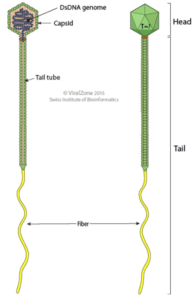

Members of the virus order Caudovirales consist of an icosahedral capsid that contains the viral dsDNA genome and a tail through which the DNA moves into the cell. Bacteriophage lambda is perhaps the best known member of the Siphoviridae (a family within the Caudovirales), which have long, non-contractile tails that attach to receptors in the bacterial outer membrane. In contrast, phages that infect Salmonella enterica, known as Chi phage, bind to flagella via a flexible filament that is attached to the end of the tail (illustrated).
How Chi phages move from the flagella to the bacterial outer membrane is not understood. Originally it was proposed that the phage DNA is injected into the flagella, from where it moves to the host. This hypothesis is not correct as there are no gaps between the flagellin protein subunits to allow DNA to enter.
The study of a newly isolated Chi phage of Salmonella enterica serovar Typhi reveals a different mechanism for how the virus delivers its DNA to the bacterium. This phage attaches to the flagellum via a protein called YSD129. The atomic structure of this protein reveals that it has the shape of a corkscrew. This observation has led to the suggestion that the protein binds flagellin and rotates in the groove that is formed by the flagellin subunits. Imagine the phage binding to flagella via the flexible tail, then corkscrewing around the rotating flagella, with each turn moving closer and closer to the bacterium.
Bacterial flagella can rotate in clockwise or counter-clockwise directions. Counter-clockwise flagellar rotation is known to cause bacteria to swim forward. Clockwise rotation causes the bacteria to tumble and sample the environment. Because the groove in the flagellin protein is right-handed, only counter-clockwise rotation of the flagellum would allow movement of the phage towards the cell surface.
Now whenever I insert a corkscrew into a cork I will think of phages surfing flagella to reach the bacterial host.

Maybe you could compose a miniaturised version of this old favourite: 🙂
https://m.youtube.com/watch?v=AYr0eNtpDHs